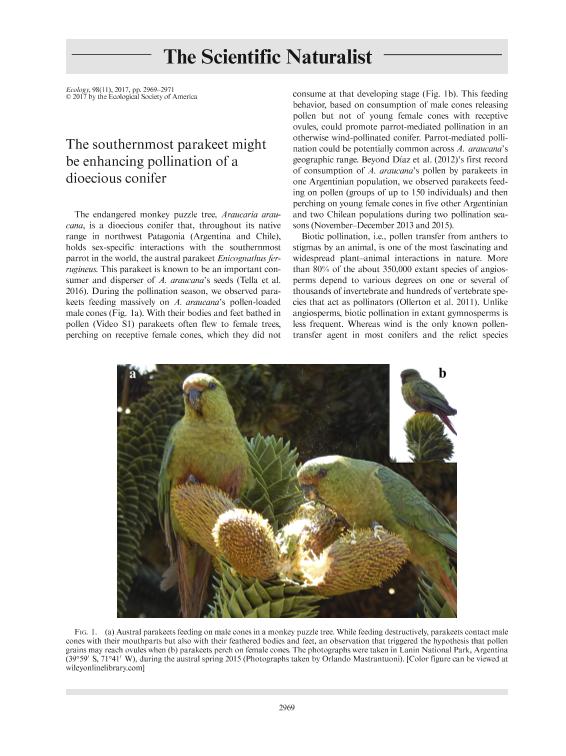Artículo
The southernmost parakeet might be enhancing pollination of a dioecious conifer
Gleiser, Gabriela Laura ; Lambertucci, Sergio Agustin
; Lambertucci, Sergio Agustin ; Speziale, Karina Lilian
; Speziale, Karina Lilian ; Hiraldo, Fernando; Tella Escobedo, José Luis; Aizen, Marcelo Adrian
; Hiraldo, Fernando; Tella Escobedo, José Luis; Aizen, Marcelo Adrian
 ; Lambertucci, Sergio Agustin
; Lambertucci, Sergio Agustin ; Speziale, Karina Lilian
; Speziale, Karina Lilian ; Hiraldo, Fernando; Tella Escobedo, José Luis; Aizen, Marcelo Adrian
; Hiraldo, Fernando; Tella Escobedo, José Luis; Aizen, Marcelo Adrian
Fecha de publicación:
11/2017
Editorial:
Ecological Society of America
Revista:
Ecology
ISSN:
0012-9658
Idioma:
Inglés
Tipo de recurso:
Artículo publicado
Clasificación temática:
Resumen
The endangered monkey puzzle tree, Araucaria araucana, is a dioecious conifer that, throughout its native range in northwest Patagonia (Argentina and Chile), holds sex-specific interactions with the southernmost parrot in the world, the austral parakeet Enicognathus ferrugineus. This parakeet is known to be an important consumer and disperser of A. araucana’s seeds (Tella et al. 2016). During the pollination season, we observed parakeets feeding massively on A. araucana’s pollen-loaded male cones (Fig. 1a). With their bodies and feet bathed in pollen (Video S1) parakeets often flew to female trees, perching on receptive female cones, which they did not consume at that developing stage (Fig. 1b). This feeding behavior, based on consumption of male cones releasing pollen but not of young female cones with receptive ovules, could promote parrot-mediated pollination in an otherwise wind-pollinated conifer. Parrot-mediated pollination could be potentially common across A. araucana’s geographic range. Beyond D ıaz et al. (2012)’s first record of consumption of A. araucana’s pollen by parakeets in one Argentinian population, we observed parakeets feeding on pollen (groups of up to 150 individuals) and then perching on young female cones in five other Argentinian and two Chilean populations during two pollination seasons (November–December 2013 and 2015).
Archivos asociados
Licencia
Identificadores
Colecciones
Articulos(INIBIOMA)
Articulos de INST. DE INVEST.EN BIODIVERSIDAD Y MEDIOAMBIENTE
Articulos de INST. DE INVEST.EN BIODIVERSIDAD Y MEDIOAMBIENTE
Citación
Gleiser, Gabriela Laura; Lambertucci, Sergio Agustin; Speziale, Karina Lilian; Hiraldo, Fernando; Tella Escobedo, José Luis; et al.; The southernmost parakeet might be enhancing pollination of a dioecious conifer; Ecological Society of America; Ecology; 98; 11; 11-2017; 2969-2971
Compartir
Altmétricas



